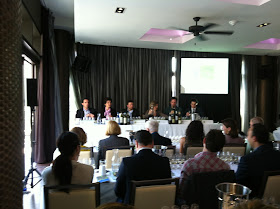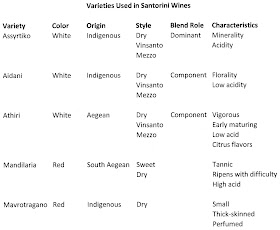Santorini's wines and winemakers were effectively showcased at a March 22nd seminar and walk-around tasting arranged by Wines from Santorini and held at the Gansevoort Park Avenue Hotel in New York City. I have previously written a post on the Santorini wine region in preparation for this event. This post focuses on the seminar that preceded the more broadly targeted walk-around tasting.
The seminar was scheduled for 11:30 am. I arrived in the hotel lobby shortly before that time and, after a few missteps, found my way to the side elevator that would take me up to the floor on which the seminar was being held. The elevator opened onto a narrow hallway with the seminar sign-up desk in that hallway to the left of the elevator door. Further down the hallway, the white tablecloths and glasses signaled the room in which the seminar would be held. After signing in I was told that preparations were still underway and was directed to the right to wait in the hotel's rooftop bar. We were finally summoned to the seminar room at 11:45 am.
The room ran east to west and was furnished with 10 to 12 rows of long tables, each set with places for six tasters. On the eastern side of the room, there was a raised platform which faced out to the room and on which were six name tags and a number of bottles of wines. This was clearly the seating for the seminar panelists. I estimate that between 40 and 45 non-panelists attended the seminar.
In its invitation email, Wines from Santorini had indicated that Jordan MacKay would be the panel leader. The panel members, and a few salient points about each, are presented in the table below.
Sofia Perpera provided opening remarks from her position on the podium. This event, according to Sofia, was part of a 3-year program to (i) increase the public's awareness of PDO wines from Santorini; (ii) establish Assyrtiko as one of the top wines in the world; and, ultimately, (iii) to encourage the grape growers in Santorini to farm this grape given all the challenges (wind, encroachment of the tourist industry, etc.) that they face. Sofia illustrated the plight of the farmer with the following statistic: in the 1800s, Santorini had 4000 ha under vine; that number had slipped to 2500 ha in the 1980s and stands at 1200 ha today. Rather than viewing tourism solely as a threat to the farmer, Sofia believes that it can be a savior for the vineyards by the tourists spreading the word of the culture after returning to their homelands. At the conclusion of her remarks Sofia introduced the panelists and the winemakers present in the room and then turned the microphone over to panel leader Jordan MacKay.
Jordan MacKay, in his opening bit, said that he finds the wines from Santorini striking and then proceeded with a presentation on the history of the islands, the location of the wine-growing areas, soil characteristics, climate, and viticulture. He closed by doubling down on his opening statement: Assyrtiko was now characterized as one of the most singular and distinctive wines in the world. And with that he proceeded to the tasting phase of the seminar.
The tasting design called for three flights of four wines each with the first two flights being dry whites and the final flight focused on Vinsanto. The dry white flights had been poured prior to our entry in the room. In an attempt to display the food-friendliness of the wines, a plate of small bites was provided for the taster to sample along with the wine if he/she so desired. The entire flight was tasted and then the panel and audience members debated the merits.
Flight 1
The wines in this flight were tasted in the following order:
2011 Gavalas Santorini
2011 Hatzidakis Santorini
2010 Karamolegos Santorini
2009 Sigalas Kavaliero
All of the above wines are 100% Assyrtiko and had alcohol levels that fell between 13% and 14%. The 2011 Gavalas Santorini had citrus, steel, zest, florality, beer and minerality on the nose and searing acidity, florality, and metal on the palate. This wine had a long, searing finish. The 2011 Hatzidakis Santorini exhibited minerality, hints of florality, and citrus on the nose. On the palate, razor-edged acidity, coating minerality, and a white pepper spiciness. The 2010 Karamolegos Santorini was more expansive on the nose than the preceding two wines with notes of burnt citrus skin. Broader on the palate with lower acidity and fuller body. Citrus zest, salinity, spiciness, and a hint of bramble. Long finish. The 2009 Sigalas Kavaliero was the only single-vineyard wine in the tasting. Salinity and citrus. Full mouthfeel with a long finish.
Paul Grieco, in remarking on this flight, noted the searing acidity and lack of sameness. He initially thought that the Karamolegos had seen oak but saw that that was not the the case.
Sofia noted that 2011 had been a great vintage in Santorini because of the frequency of winds during the summer and that was good for the vines because these winds are their only source of moisture. She felt that 2011 was a year with added dimension. For example, it was one of the most aromatic vintages ever. One of the other panelists noted that the minerality of these wines was like brimstone; it was intense but the wines still had great balance.
Michael Madrigale found the Sigalas to be rich and expressed a preference for having these wines with food. Grieco thought that the wines would be a great match for salads. Jordan thought that they would match well with olives, sharp feta cheese, onions, and capers. The wines could be aperitifs but they scream out for food. Someone from the audience suggested lamb with lemons.
Tom Pastuszak remarked on the intense saline minerality of the wines while Madrigale commented on the complex aromas of wines 2 and 3. Wine 2 had bitter herb and mustard grain aromas while wine 3 had asphalt and exhaust aromas. Sofia commented that this, the modern style of Santorini wines, came into being after the 1980s. Prior to that time, the style had been more oxidative.
Flight 2
The wines in this flight were tasted as follows:
2009 Estate Argyros
2010 Santowines Nykteri
2011 Gaia Assyrtiko Wild Ferment
2007 Boutari Kallisti Reserve
All of the wines of this flight are 100% Assyrtiko and all have seen oak. The 2009 Estate Argyros has been 20% fermented in new French oak. On the nose, oak and toasted wood. On the palate searing acidity flattened out by the oak, minerality, salinity, creme brûlée with burnt sugar. Alcohol on this wine is 13%. The 2010 Santowines Nykteri was aged for 3 months in new French oak. On the nose oak, baking spices, vanilla. Weighty on the palate with burnt orange, smoke, and a creamy richness. The 2011 Gaia Assyrtiko Wild Ferment was fermented using wild yeast with 50% of the fermentation carried out in stainless steel tanks. Aged in barrel for 5 months. On the nose: smoke, dill, baking spices, and burnt citrus. Searing acidity. Saline and some oak tannins. The most floral of the wines in this flight. A slight vegetal note. Spicy. The 2007 Boutari Kallisti Reserve was fermented in oak and then aged for 7 months in French oak. Evidence of oxidation. Sherry-like. Burnt orange peel and peppery. Hotter than the other wines in this flight.
Paul Grieco opened up the panel comments by saying that he saw no uniqueness in these wines and, further, that he would prefer to speak to a winemaker than a lumber merchant (That was truly funny and quite characteristic of Grieco's acerbic wit.). Madrigale jumped to the flight's defense with the comment that oak can help Assyrtiko to work with food by softening its sharp edges and by broadening the types of food with which it could be paired.
Flight 3
The wines in this flight were tasted as follows:
2006 Roussos Vinsanto
2004 Santowines Vinsanto
2000 Koutsoyiannopoulos Vinsanto
1989 Argyros Vinsanto
The 2006 Roussos Vinsanto is a blend of 65% Assyrtiko, 15% Aidani, and 15% Athiri. It has 180 g/l of residual sugar and 11.5% abv. On the nose honey, figs, molasses, oxidation, and burnt citrus. On the palate great balance between acidity and sugar. The 2004 Santowines Vinsanto is a blend of 80% Assyrtiko and 20% Aidani with 238 g/l of residual sugar and 10.9% abv. Piney oak note. Phenolic. Honey. On the palate weighty, thick, rich. Long, balanced finish. The 2000 Koutsoyiannopoulos Vinsanto is 60% Assyrtiko and 40% Aidani with residual sugar of 280 g/l and 13% abv. This wine had the deepest color of all the wines in this flight. Heavy and thick with figs, dates, cough syrup and almonds on the nose. Unbalanced. The final wine of the flight and of the seminar was the 1989 Argyros Vinsanto. This wine is a blend of 80% Assyrtiko, 10% Aidani, and 10% Athiri and has residual sugar of 240 g/l and 10% abv. On the nose green bark, pine, dill, syrupy, honey, and creme caramel. On the palate thick, rich and smooth with a smooth, long finish.
***********************************************************************************************************
At this time the seminar was brought to a close so that the walk-around tasting could begin on time. The tasting phase of the seminar had been somewhat unbalanced with the first flight getting significantly more discussion time than did the final flight but that might have been predicted given human nature. All in all it was a very revealing and informative seminar which accomplished the task of showcasing the wines and educating the attendees about the region. I think that the organizers did a great job of panel selection by building a panel of young, hip sommeliers with out-of-the-box perspectives balanced by significant wine-related accomplishments.
Paul Grieco made a comment that people who really appreciate wine are at heart acid hounds. And I agree with him. For an acid hound, Assyrtiko hits a sweet spot. For me it aligns with a Margaret River Chardonnay, a Chablis, or a Loire Valley Sauvignon Blanc. It does not have similar characteristics to those wines -- they are each unique in their own way -- but it possesses the aura of greatness that surrounds them all. I am not similarly disposed to the Nykteri style of Assyrtiko, but that is a personal choice. To me the oak alters the trajectory of the natural acidity and softens up the wine.
The Vinsanto is sublime.
© Wine -- The View From Orlando





























